Posts
1st. INFORMATION GOVERNANCE Conference for the Legal Market
- - By : JPG
- Date : 11-Feb-17
- Leave a comment
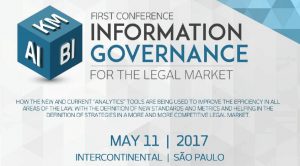
How the new and current “Analytics” tools are being used to improve the efficiency in all areas of the Law, with the definition of new standards and metrics and helping in the definition of strategies in a more and more competitive legal market. – May, 11, 2017 – Intercontinental/ São Paulo.
An innovating meeting for the legal market. Get to know how the digital transformation and the information management will fully change the legal businesses in the years to come.
With the participation of International Keynote Speakers: Mark Smolik- Chief Legal & Compliance Officer DHL Supply Chain Americas;
Patrick Didomenico- Chief Knowledge Officer, Ogletree, Nash, Smoak & Stewart, PC- New York, USA, and author of the book “Knowledge
Management for Lawyers”.
Get updates with the debates that will define the future of Law in the world!
– Artificial intelligence as a support in the process management
– Information governance for decision making
– Views of the legal departments and law firms about the digital transformations in the market
– The new lawtechs
– How the investment in technology and intelligence may revert into better productivity and results
SEE ALL THE INFORMATION:
GI_Programacao_A4_EN_optimize
Law Firms have Clients or Customers ?
- - By : JPG
- Date : 09-Feb-17
- Leave a comment
 Let us begin by checking the definitions of the entries which are contained in the Houaiss (Portuguese) dictionary:
Let us begin by checking the definitions of the entries which are contained in the Houaiss (Portuguese) dictionary:
Client: A person that entrusts the defense of his/her interests or rights to an attorney, a prosecutor or a notary officer; a person that hires services or buys goods by means of payment; a buyer, customer, a person that always consults the same doctor, dentist, etc.
Consumer: the one or that one that consumes; the one or that one that buys goods, resources or services for his/her own use or for the use of his/her family: a buyer, a customer, a client.
The first analysis that we can make is that, although they are almost synonyms, the definition of client suggests, in its interpretation, an existing relationship between the supplier and the consumer, a consumption habit or some loyalty before the former, whereas the word consumer suggests the simple act of timely consumption of a product or a service (an analysis that is very well elaborated by Adelle Sommers in her article “Client or Customer? You Decide”, written in 2007).
In addition to the aforementioned analysis, I would like to add another one, a very important one, which has to do with two aspects that are purely psychological: tolerance and accommodation.
The relation of a punctual consumption is much more impersonal (without practically any engagement between the consumer and the supplier), with much more freedom of choice among suppliers and also added by practically no tolerance regarding failures or defects, no matter how small they might be. As an example, I mention our individual characteristic of choosing and buying a consumer good. Firstly, we analyze the characteristics that we want, then we set off to the choice of the supplier (all this made easier by the use of the internet and the search engines) and, in the end, at the time of the choice, if it is in person, we choose the piece that has no defect (a scratch, dirt, any mark of use) and disregarding those ones that have the capacity to fulfill us functionally, but whose esthetics is compromised.
The supplier / client relationship is longer, there is a bigger engagement between the parties and the freedom of choice is smaller (it presupposes the need to terminate the contract). Due to the two previous characteristics, one ends up having a certain tolerance to small mistakes by the supplier and also accommodation of both parties and therein lies the danger!
It is exactly this bigger tolerance and accommodation of the client (compared to the timely consumption) that generates the accommodation of the supplier and, as a consequence, the slow and, sometimes,imperceptible decrease of the quality of the products or of the rendered services.
In the current market stage, it is fundamental that any company should begin to treat their clients as consumers and should leave this comfort zone!
And bringing the topic to the universe of the law offices, we face some difficulties for the implementation of this concept and of the change.
1-) The fact (that I already mentioned in another discussion) of the office leaders refusing to admit that their businesses are companies! The phrase: “a law office is not a company” or “the profession has no trading objective whatsoever” are absolutely outdated and refers to a time when the attorney-client relationship was much different from the current one.
2-) And also the fact that the offices are neither much used to competitiveness nor to the volatility of their clients. This market (of corporate offices) is reasonably small; it had its growth in the 90’s and it still has relatively a few “players.”
The big evolution of this market will occur when the current “players” begin to change the posture of the law offices to companies that render legal services and treat the clients as consumers, running the risk of losing their statuses and being engulfed by those which will do that!
José Paulo Graciotti, is consultant and founding Partner of GRACIOTTI ASSESSORIA EMPRESARIAL, engeneer by Escola Politécnica Universidade de São Paulo, with Financial MBA at FGV and specialized in Knowledge Mnagement by FGV. ILTA Member since 1998 (International Legal Technology Association) with more than 27 years managing Law Firms in Brazil – www.graciotti.com.br
Professional help to MANAGING LAW FIRMS
- - By : JPG
- Date : 08-Feb-17
- Leave a comment
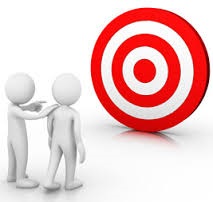 I use to make a metaphorical comparison of the LAW FIRM management with a chess game, (used in the conceiving of my site: www.graciotti.com.br) where the movement of any piece may (and sometimes, it really does) radically change the distribution of forces and options of future´s game movements on a chessboard. In addition to the challenges that any company may have (competitiveness, quality, marketing, support, etc), there are other factors which are inherent to the characteristics of the business of the law firms and mainly to the lawyer’s profession.
I use to make a metaphorical comparison of the LAW FIRM management with a chess game, (used in the conceiving of my site: www.graciotti.com.br) where the movement of any piece may (and sometimes, it really does) radically change the distribution of forces and options of future´s game movements on a chessboard. In addition to the challenges that any company may have (competitiveness, quality, marketing, support, etc), there are other factors which are inherent to the characteristics of the business of the law firms and mainly to the lawyer’s profession.
A lawyer is a professional who presents a peculiar behavior and it is necessary to understand it in order to be able to analyze and understand the way how several firms are structured and managed.
The first psychological characteristic is the very low tolerance to failures..Due to the profession, the lawyer must not make failures in his/her arguments, presented documents or statements (whether regarding laws, doctrine or jurisprudence) running the risk that his/her arguments may be destroyed by his/her opponents, not to mention the more ordinary failures, but much more serious ones, such as the failure to fulfill deadlines, non-collection of fees, which disqualify the proceeding before the courts, and also without considering the merit of the issue involved.
Another factor we have to consider is the lawyer’s educational degree that collaborates with the repugnance and, I would also dare to say, the ignorance that the majority has in relation to the theories, techniques and the entire know-how that is already developed in the world of the entrepreneurial management.
One must not blame this professional who graduated in schools that emphasize the technical-theoretical improvement, but forget to provide the minimum information in the management area. I am not criticizing the Law Schools, but giving a sign of alert about the importance of a more eclectic education of the professionals. That was one of the biggest difficulties I felt when I graduated from Polytechnic School (which was and still is very important in my technical and personal training) and also when I faced the real world, where other attributes were expected for the personal development of my career, in addition to those ones I had learned at school regarding structures, calculation, foundations, etc.
The management of companies in the highly competitive current scenario and in constant change and now, in recession, demands characteristics from their managers such as creativity, resilience and innovation, which obligatory go though experimentation processes, learning with the failures (and not being recurrent) and constant corrections of the route.
This dynamic process is head on opposed to the behavior to which the lawyer was trained and is used to having in relation to the solution of his/her challenges, which demands the lawyer the education he/she did not gain in college and also constant updating, to which he/she has no time to dedicate.
In this scenario, the importance of hiring a consulting firm increases a lot, which will add to the innate attributes relative to those lawyers who began their businesses, the specific knowledge of the entrepreneurial management areas and also the experience gathered in previous experiences as, using the metaphor of the sailboat and the wind, instead of complaining about the lack of wind (pessimistic) or even hoping the wind will blow again (optimistic), we must be realistic and adjust the sails!
This adjustment will be different for each office and is the consultant’s task to identify the limitation of each one or to help solving those ones already identified by their managers. There are several issues to be improved and I mention the more critical ones, which in my experience of over 27 years working with managers lawyers, I have observed: the adoption of the philosophy of the “management of the know-how, adoption of systems of extraction of statistics of internal information (Business Intelligence is just one of them); creation of controls and appropriation of costs per client/case or area of performance; adoption of a short and mid-term strategic plan, creation and follow-up of the budgets and pricing of services, adoption of talent retention policies and professional motivation; adoption of a career and remuneration plan for the legal and back office team.
It is appropriate to refer to two points to be considered when choosing a consulting firm: first, to ensure that it effectively has practical experience of several years of performance (in order to avoid the purely non-tested theoretical-academic counseling) and, second, to ensure that it has specific experience in the law’s firms market niches which have very distinctive characteristics.
José Paulo Graciotti, is consultant and founding Partner of GRACIOTTI ASSESSORIA EMPRESARIAL, engeneer by Escola Politécnica Universidade de São Paulo, with Financial MBA at FGV and specialized in Knowledge Mnagement by FGV. ILTA Member since 1998 (International Legal Technology Association) with more than 27 years managing Law Firms in Brazil – www.graciotti.com.br
Technology leads an engineer to the partner position in the Law business
- - By : JPG
- Date : 08-Feb-17
- Leave a comment
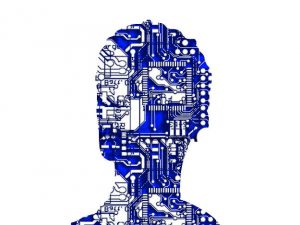 The path of José Paulo Graciotti began to change from Engineering to Law when the first personal computers appeared and one of the biggest law firms of the country decided to use them.
The path of José Paulo Graciotti began to change from Engineering to Law when the first personal computers appeared and one of the biggest law firms of the country decided to use them.
São Paulo- When the first computers, the PCs, began to appear for domestic use, one of the biggest law offices in Brazil called an engineer to implement the new technology. The engineer was José Paulo Graciotti, “Zé Paulo”.
He had left Gafisa not long ago, after ten years of a career in the civil construction. As he had participated in the implementation of the information technology master plan in the construction company, a personal friend recommended him to work for Demarest, in 1988.
To the standards of that time, the engineer tells us that the office, with 30 to 40 lawyers, was considered a big one and had Pinheiro Neto office as its only rival. “This transition to Law was kind of deviated. It was not something I had planned”, states Zé Paulo.
So far, even the biggest offices were managed by their own attorneys, Zé Paulo explains. The figure of a general director or a chief executive, dedicated only to the management, did not exist. But in the late 90’s, after over a decade in the Law firm, Zé Paulo says he was called to be the firm’s partner.
“Surely I was the first one to take over this position”, he says, currently performing as a management consultant for law firms. As the Brazilian law offices have grown much, the choice of one executive to head the office is much more common. “But, at that time, that was something very new”, he highlights.
While he was at Demarest, the consultant remembers that, with his help, the law firm was the first one to implement a corporate fax system that sent the files directly to the computer, with no need to printing. He also highlights that, under his control, the office was pioneering in the implementation of an invoicing system specific for the legal sector, at that time, a revolutionary management novelty.
Innovation
However, the affinity with technology and innovation did not stop there. In 2002, when Demarest had already almost 500 professionals, there was a split-up and Zé Paulo became a member of the breakaway group, of about 20 attorneys in order to incorporate the KLA.
In the second office, the consultant implemented a software unit with a strong component of knowledge management. According to the consultant, this technology is an internal search engine for data that enables the attorneys to work in a more efficient way.
Convinced that the concept of knowledge management is one of the law secrets of the future, Zé Paulo says that the problem of a big office is the difficulty to catch-up the technological evolutions. “Technology is growing in an astounding speed. It has been very difficult to catch-up. And several offices are still managed by guys like me, from the generation of babyboomers”, he says, now 61 years old.
If, on one hand, Zé Paulo cultivates a collection of pens which he inherited from his father, who was a physician, on the other hand, he is very much attentive in relation to the digital habits of the law firms. “The offices need to reinvent themselves. Even the marketing segment is outdated. Just observe what is inserted on the LinkedIn. Always the same thing. Everything needs to be changed or they will be hit.”
One of the problems of the offices nowadays, says the specialist, is that they have no control over the main product, that is the knowledge. “I am used to saying that the main equity of the office goes down the elevator every day and goes back home. That is, if the people are not there, in the office, it is worth nothing.
For this reason, Zé Paulo says that it is important for the office to have mechanisms in order to retain the knowledge produced by the professionals. “The one who receives the royalties of a drug is not the scientist, but the pharmaceutical industry”, he adds.
The Future
The engineer says that, in addition to dedicating himself to the study of the technological changes, another motivation of his is to dedicate the years of experience in the offices in order to help new entrepreneurs in the field to evolve more rapidly. In the end of last year, he left KLA -which is currently a law office with 180 professionals – to dedicate himself to perform as a consultant.
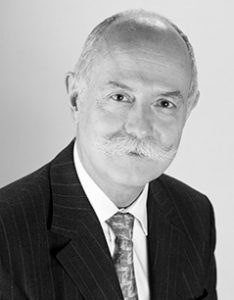 Jose Paulo Graciotti
Jose Paulo Graciotti
Consultor em Gestão Empresarial e fundador da GRACIOTTI Assessoria Empresarial Ltda.
The FUTURE LAWYER
- - By : JPG
- Date : 08-Feb-17
- Leave a comment
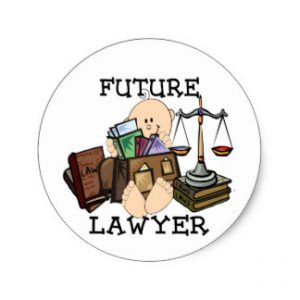 It is undeniable that all of us, professionals and companies, are being forced to adapt ourselves to the huge content of information that bombards us daily and mainly to the increasing pace of all changes that our society is facing nowadays.
It is undeniable that all of us, professionals and companies, are being forced to adapt ourselves to the huge content of information that bombards us daily and mainly to the increasing pace of all changes that our society is facing nowadays.
The exponential growth of information in the digital media such as court judgments, pleadings, contracts, opinions, e-mails and others create by itself an increasing difficulty in the search, correct identification and analysis of information that are relevant to the needs of a lawyer but, on the other hand, the capacity of analyzing information, the synthesis of ideas and arguments, and the preparation of legal documents still rely on people and on their human limitations.
Two other important factors also increasingly pressure the legal profession: The first one is the pressure that the customers exert in order to obtain faster and obviously correct solutions and the second one is the competitive pressure, forcing the professionals to better manage their costs and be able to offer more competitive prices, always maintaining the quality. (I point out that quality is not the only differentiation factor anymore because, as an example, I mention the fact that the Brazilian market has evolved from a few corporate firms to hundreds of good ones in a period of 3 decades.)
As if all this were not enough, there is still the pressure exerted by the change of behavior of the society itself, more and more connected with everything, everybody and at the same time, increasingly generating a sense of urgency and a expectative for immediate results across it.
Because of all this pressure and also because of the human limitation, the legal professional was obliged to find an ally in order to face all these challenges and evolve, and this ally is called technology! Although it does not seem so (in the eyes of a non-lawyer) the legal profession is one of those that mostly needs and depends on technology in order to provide efficient and responsive services.
The technology is treated by the lawyer (and could not be otherwise) as a means and not an end and should be used as a very powerful tool improve efficiency and effectiveness in the profession. Thus, the more complete lawyer that will be more competitive and prepared for the challenges of his/her profession must have:
– More comprehensive knowledge on issues related to human relations in order to better manage his/her team and his/her talents by adopting motivating challenges and using specific “KPI’s”, besides more modern career paths adapted to the new generations.
– A better knowledge of Institutional and Personal Marketing in order to increase his/her market share through modern techniques of participation and projection in the digital media.
– A better training in business management in order to economically, financially and strategically manage his/her company with the help of ERP software, BI, and so on.
– Familiarity and the use of technologies that generates his/her documents through “docmentassembly” software.
– The necessary technologies and know how to make the most of them in order to:
– Find as quickly as possible all the information needed in order to produce his/her legal document with the help of search robots and/or cognitive intelligence software.
– Properly manage his/her strategic knowledge (explicit or tacit), organizing it and indexing it for future use.
– Statistically analyze jurisprudence and previous decisions of courts and judges.
Although technology is just a tool, all these activities will be devised and managed by lawyers through software and intelligent systems which will require from them a much more eclectic and technological training than the merely technical training that these professionals are being submitted in the universities.
More and more and along all their career, besides their own specific update in Law, the lawyers will be compelled to become professionals with more comprehensive knowledge such as: team and people management, business management, institutional and personal marketing, communication and mainly affinity with technology and with the digital world (to avoid the risk of becoming a Jurassic professional).
José Paulo Graciotti, is consultant and founding Partner of GRACIOTTI ASSESSORIA EMPRESARIAL, engeneer by Escola Politécnica Universidade de São Paulo, with Financial MBA at FGV and specialized in Knowledge Mnagement by FGV. ILTA Member since 1998 (International Legal Technology Association) and ALA (Association of Legal Administrators), with more than 27 years managing Law Firms in Brazil – www.graciotti.com.br
PARTNER COMPENSATION STRUCTURE – THERE IS NO PERFECT FORMULA
- - By : JPG
- Date : 08-Feb-17
- Leave a comment
In every society, there is a “bond” or “links” among its members that may have several features, but the main one is the individual conscience that being together is better than being alone.
In law firms, this glue is mainly represented by a technical complementarity, that is, lawyers from different specialties that get together in order to render a more complete service to their clients. Besides it, for the society to prosper, other characteristics are also necessary in order to feed its growth, such as: entrepreneurial vision, technical knowledge, relationships and capturing capacity and skill in managing clients and staff.
All those attributes, when “gathered and mixed” (referral to a fashion expression)) make up the relativisation matrix among partners, but the way it is structured and the importance given to each attribute varies from one office to another and the result of its use in the partners’ compensation model may become the weak link of the chain that gathers them.
The first aspect we should understand is that this matrix of attributes may not be correctly applicable, mainly due to the lack of reliable data and/or information for the correct marking out among their participants. This constraint may be higher or lower, depending on the degree of the maturity of the controls in which the society is in each of its growth phase. One expects that in the initial months or years, the organization has no sufficient financial good standing to invest in administrative managerial structure and systems able to produce the necessary reports.
Another very important aspect to be taken into account is the so-called entrepreneurial philosophy adopted by the company which, in the law offices, tends to be the mirroring of the individual characteristics of their founding partners. Example: an office that is incorporated by an attorney with a predominantly profile for client attraction will have in its initial times the tendency to value this attribute of its stakeholders and partners.
Regardless of the previously analyzed aspects, we can practically place in a bi-dimensional matrix those two perspectives of how the partners see the philosophically correct forms for self – relativisation and control of the investment, costs and expenses of their organization.
In the first item, this relativisation may vary from a more subjective “approach” of equivalence among the partners, imagining that each individual has his more or less developed capabilities for each one of the five characteristics that make up the “glue” among the partners (referred to above) and which compensate themselves making them equivalent and (lockstep), up to the extreme end where what is of interest is what one can attract, produce and invoice (eat-what-you-kill).
In the second item, we can vary from the complete socialization of all investments, costs and expenses, where all that is under the institution liability, regardless of its originator, need, sector or partner, up to the other end where all expenses are individualized and computed as being under the generator’s liability.
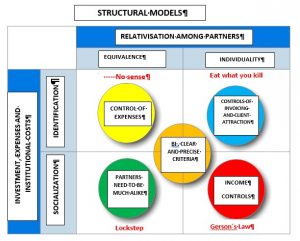
In the lower left quadrant we have the equivalence among partners, that is, there is a compensation among the five attributes that make up the “glue”, the partners must be technically alike and the expenses (investments, costs and expenses) are socialized in the institution. In this quadrant the “lockstep” form of relativisation can be perfectly fit, but it is only kept if there is no big variation among the individual dedication and commitment by each partner along the time.
In the upper right quadrant one finds the concept that is diametrically opposed to the previous one, where each partner is valued due to his individual characteristics and according to the importance given to the attributes in the company and normally to those that represent “cash on hand”. In the scope of the expenses, there is also the identification and its total individualization by the partners or the sector to which he is responsible for. In that model, each sector operates as a totally independent cell, as if it were an office within an office. In this quadrant, one can identify the offices of the so-called “eat-what-you-kill” philosophy.
In the lower right position we have what I refer to as the “Gerson’s Law” quadrant and for those who are young and do not know anything about it, I briefly explain: The soccer player of the three- time world champion team of 1970 starred in one advertisement for cigarettes where he said “I like to take advantage of all, right?” and unfortunately (to him) this ended up generating, along the time, the negative image of the smart person!
In our case this is the image one wants to convey, as in this quadrant the revenues are computed in the individuality generating higher importance to its generator and the expenses are socialized among all. This is not a formula that will work out right along the time!
In the upper left position one finds the quadrant with the equivalence among the partners and the individualization of the expenses, which it the denial to the own philosophy of equivalence and, as far as I am concerned, there is no office in this situation (but it is there for didactic purposes only).
I am not going to define as right or wrong the perspectives described and simplified in the picture above, because I am quite sure that every firm defines their own and that blends with the characteristics of the managing partners, but anyway I will express my humble opinion: I consider the intermediate situation existing between the lower left quadrant and the upper right, providing they have well defined attributes as well as correct and trustable reports, the more rational situation and the one that have a better chance of survival along the time!
José Paulo Graciotti, is consultant and founding Partner of GRACIOTTI ASSESSORIA EMPRESARIAL, engeneer by Escola Politécnica Universidade de São Paulo, with Financial MBA at FGV and specialized in Knowledge Mnagement by FGV. ILTA Member since 1998 (International Legal Technology Association) and ALA (Association of Legal Administrators), with more than 27 years managing Law Firms in Brazil – www.graciotti.com.br
WRAP-UP OF THE YEAR, TRENDS FOR 2017 AND FUTURE IN THE LEGAL MARKET”
- - By : JPG
- Date : 19-Jan-17
- Leave a comment
This year was (and still has been) very much busy in the scope of the legal events and I can not remember having seen anything similar in the recent past, but it was also the stage for the boom of technological changes that began to undermine the governance structure of the traditional Brazilian legal market.
I refer to the breakneck growth of the technologies of the so-called “Artificial Intelligence” which, suddenly blossomed like mushrooms that sprout in a moist morning of a dark forest.
For 20 yearsI have been a member of an association which is focused on the study and development of technology for law firms in the USA and just to get an idea, from 2015 to 2016, 35 companies emerged presenting products and services focused on this market with the use of cognitive technologies.
For clearer contextualization, the term “Artificial Intelligence”, in fact, covers a series of technologies and mathematical and statistic algorithms, which allow the machine to “learn” cognitively beyond the yes or no binary and to be able to make decisions based on previous experiences. Below, there is a slide taken from a presentation of “NeotaLogic”, which very well illustrates this theme:

In addition, there are a dozen of mathematical and statistical algorithms that can be used for the several areas of Law, such as: regression, decision trees, neural networks, “ensemble”, “deeplearning” etc.
All those technologies enable:
1 – The cognitive identification of documents and the extraction of themes that are approached internally not only by means of the words contained but also by means of their semantic meaning.
2 – Classification and automatic distribution of those documents to the professionals who hold know-how that is coherent to its content.
3 – Intelligent Research (again not only by means of words) of the information that is necessary to the elaboration of a new document such as, jurisprudences, doctrines, previous cases, etc.
4 – The automatic elaboration, per se, of the documents based on answers to thematic questions. Example: creation of contracts about specific themes.
5 – Forecast, that is, the statistic analysis of prior judgments and estimate of “gain or loss” of a given thesis in a given Court.
All this is imposing on the entire legal market (offices, legal departments and even judges and Courts) a big change in the way one looks, understands, behaves and mainly manages the legal profession.
In a period that I think will last for a long time where there is a scarcity of financial resources in the market, with the most violent competition and all the companies looking for efficiency and productivity, the adoption of these technologies will allow the beginning of the introduction of these concepts on the well-established legal market.
I am not advocating a “dark”vision of the future of the profession, where the robots will dominate the legal world, but warning the professions of the area to be aware of this trend and to be resilient enough to adapt themselves.
I have always advocated the theory that the lawyers should have a very good capacity for analysis (in order to understand the challenge and all its implication) and also a good capacity for synthesis (where he/she can express the solution of the challenge), and, in the current situation, such professional should more use his/her experience, his/her knowledge, and mainly his/her intellectual capacity and leave the search and analysis job to the machines.
The legal professional of the future, that is already present, will use more the brain and less the hands.
José Paulo Graciotti, is consultant and founding Partner of GRACIOTTI ASSESSORIA EMPRESARIAL, engeneer by Escola Politécnica Universidade de São Paulo, with Financial MBA at FGV and specialized in Knowledge Mnagement by FGV. ILTA Member since 1998 (International Legal Technology Association) and ALA (Association of Legal Administrators), with more than 27 years managing Law Firms in Brazil – www.graciotti.com.br
Governança e Inovação
- - By : JPG
- Date : 30-Nov-16
- Leave a comment
Tive a honra de ser convidado e de participar do 23º encontro anual de sócios do TRIGUEIRO FONTES ADVOGADOS no ultimo dia 26/11, quando coordenei o workshop “GOVERNANÇA e INOVAÇÃO” onde foram apresentadas as novas tendências na governança de Escritórios de Advocacia e discutidas as bases para para o planejamento estratégico da empresa para o próximo quinquênio.
Obrigado e Parabéns ao TRIGUEIRO FONTES !





